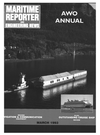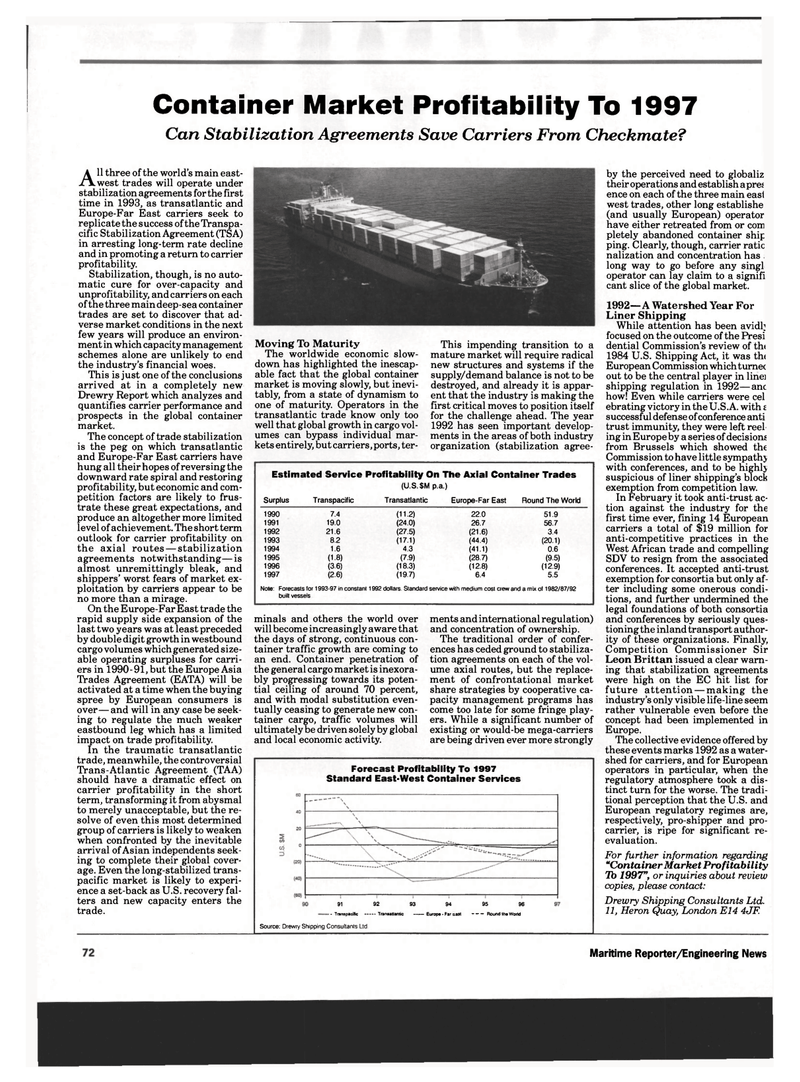
Page 70: of Maritime Reporter Magazine (March 1993)
Read this page in Pdf, Flash or Html5 edition of March 1993 Maritime Reporter Magazine
Container Market Profitability To 1997
Can Stabilization Agreements Save Carriers From Checkmate?
All three of the world's main east-west trades will operate under stabilization agreements for the first time in 1993, as transatlantic and
Europe-Far East carriers seek to replicate the success of the Transpa- cific Stabilization Agreement (TSA) in arresting long-term rate decline and in promoting a return to carrier profitability.
Stabilization, though, is no auto- matic cure for over-capacity and unprovability, and carriers on each of the three main deep-sea container trades are set to discover that ad- verse market conditions in the next few years will produce an environ- ment in which capacity management schemes alone are unlikely to end the industry's financial woes.
This is just one of the conclusions arrived at in a completely new
Drewry Report which analyzes and quantifies carrier performance and prospects in the global container market.
The concept of trade stabilization is the peg on which transatlantic and Europe-Far East carriers have hung all their hopes of reversing the downward rate spiral and restoring profitability, but economic and com- petition factors are likely to frus- trate these great expectations, and produce an altogether more limited level of achievement. The short term outlook for carrier profitability on the axial routes — stabilization agreements notwithstanding—is almost unremittingly bleak, and shippers' worst fears of market ex- ploitation by carriers appear to be no more than a mirage.
On the Europe-Far East trade the rapid supply side expansion of the last two years was at least preceded by double digit growth in westbound cargo volumes which generated size- able operating surpluses for carri- ers in 1990-91, but the Europe Asia
Trades Agreement (EATA) will be activated at a time when the buying spree by European consumers is over— and will in any case be seek- ing to regulate the much weaker eastbound leg which has a limited impact on trade profitability.
In the traumatic transatlantic trade, meanwhile, the controversial
Trans-Atlantic Agreement (TAA) should have a dramatic effect on carrier profitability in the short term, transforming it from abysmal to merely unacceptable, but the re- solve of even this most determined group of carriers is likely to weaken when confronted by the inevitable arrival of Asian independents seek- ing to complete their global cover- age. Even the long-stabilized trans- pacific market is likely to experi- ence a set-back as U.S. recovery fal- ters and new capacity enters the trade.
Moving To Maturity
The worldwide economic slow- down has highlighted the inescap- able fact that the global container market is moving slowly, but inevi- tably, from a state of dynamism to one of maturity. Operators in the transatlantic trade know only too well that global growth in cargo vol- umes can bypass individual mar- kets entirely, but carriers, ports, ter-
This impending transition to a mature market will require radical new structures and systems if the supply/demand balance is not to be destroyed, and already it is appar- ent that the industry is making the first critical moves to position itself for the challenge ahead. The year 1992 has seen important develop- ments in the areas of both industry organization (stabilization agree-
Estimated Service Profitability On The Axial Container Trades (U.S. $M p.a.)
Surplus Transpacific Transatlantic Europe-Far East Round The World 1990 7.4 (11.2) 22.0 51.9 1991 19.0 (24.0) 26.7 56.7 1992 21.6 (27.5) (21.6) 3.4 1993 8.2 (17.1) (44.4) (20.1) 1994 1.6 4.3 (41.1) 0.6 1995 (1.8) (7.9) (28.7) (9.5) 1996 (3.6) (18.3) (12.8) (12.9) 1997 (2.6) (19.7) 6.4 5.5
Note: Forecasts for 1993-97 in constant 1992 dollars. Standard service with medium cost crew and a mix of 1982/87/92 built vessels minals and others the world over will become increasingly aware that the days of strong, continuous con- tainer traffic growth are coming to an end. Container penetration of the general cargo market is inexora- bly progressing towards its poten- tial ceiling of around 70 percent, and with modal substitution even- tually ceasing to generate new con- tainer cargo, traffic volumes will ultimately be driven solely by global and local economic activity. ments and international regulation) and concentration of ownership.
The traditional order of confer- ences has ceded ground to stabiliza- tion agreements on each of the vol- ume axial routes, but the replace- ment of confrontational market share strategies by cooperative ca- pacity management programs has come too late for some fringe play- ers. While a significant number of existing or would-be mega-carriers are being driven ever more strongly
Forecast Profitability To 1997
Standard East-West Container Services 91 - Transpacific 92 ... Transatlantic 93 94
Europe - Tar cast 95 96
Round the Wortd
Source: Drewiy Shipping Consultants Ltd by the perceived need to globaliz their operations and establish a pres ence on each of the three main east west trades, other long establishe (and usually European) operator have either retreated from or com pletely abandoned container ship ping. Clearly, though, carrier ratic nalization and concentration has long way to go before any singl operator can lay claim to a signifi cant slice of the global market. 1992—A Watershed Year For
Liner Shipping
While attention has been avidl; focused on the outcome of the Presi dential Commission's review of tht 1984 U.S. Shipping Act, it was the
European Commission which turnec out to be the central player in line: shipping regulation in 1992—anc how! Even while carriers were eel ebrating victory in the U.S.A. with £ successful defense of conference anti trust immunity, they were left reel ing in Europe by a series of decisions from Brussels which showed the
Commission to have little sympathy with conferences, and to be highlj suspicious of liner shipping's block exemption from competition law.
In February it took anti-trust ac- tion against the industry for the first time ever, fining 14 European carriers a total of $19 million for anti-competitive practices in the
West African trade and compelling
SDV to resign from the associated conferences. It accepted anti-trust exemption for consortia but only af- ter including some onerous condi- tions, and further undermined the legal foundations of both consortia and conferences by seriously ques- tioning the inland transport author- ity of these organizations. Finally,
Competition Commissioner Sir
Leon Brittan issued a clear warn- ing that stabilization agreements were high on the EC hit list for future attention—making the industry's only visible life-line seem rather vulnerable even before the concept had been implemented in
Europe.
The collective evidence offered by these events marks 1992 as a water- shed for carriers, and for European operators in particular, when the regulatory atmosphere took a dis- tinct turn for the worse. The tradi- tional perception that the U.S. and
European regulatory regimes are, respectively, pro-shipper and pro- carrier, is ripe for significant re- evaluation.
For further information regarding "Container Market Profitability
To 1997", or inquiries about review copies, please contact:
Drewry Shipping Consultants Ltd. 11, Heron Quay, London E14 4JF. 100 Maritime Reporter/Engineering News

 69
69

 71
71
